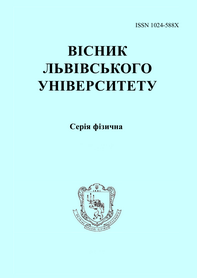Visnyk of the Lviv University. Series Physics
58 (2021) ñ. 50-60
DOI: https://doi.org/10.30970/vph.58.2021.50
Polarized photoluminescence of dicyanomethylene pyran and its derivatives thin films obtained by the oblique angle deposition technique
I. Karbovnyk, B. Turko, V. Vasilyev, A. Kukhta, O. Kushnir, H. Klym
|  |
The oblique angle deposition method of thin organic films can be used in the production of OLED devices with an approximately 30\% increase in quantum efficiency. During the adsorption of the evaporating substance on the substrate, islands are formed. If the substrate is located at an oblique angle to the flow of vapor, these islands shade some part of the substrate and prevent the flow of vapor into the shaded area. This leads to an ordered, porous and columnar growth of the film. In this paper, we study how the specifics of this method affects polarized photoluminescence from thin films of dicyanomethylenepyran and its derivatives. We compare the samples obtained using the method of thermal vacuum evaporation on glass substrates in two different geometries: placed perpendicularly and at 10 degrees angle to the flow of the precipitated substance vapor. A characteristic feature of DCM, which determines its functional properties, is the simultaneous presence of donor and acceptor groups connected by an unsaturated bridge in the molecule. This leads to a noticeable separation of charges of different signs in the ground state, which increases with excitation. Charge separation in the DCM molecule provides it with a significant dipole moment both in the ground and in the electronically excited states and determines its electrical properties. For the same reason, the positions of the absorption and fluorescence bands depend on the polarity of the solvent. Equilibrium geometry in the ground electronic state helps to understand the possible interaction and location of molecules. Photoluminescence spectra of DCM, DCM-5, DCM-17 and DCM-18 thin films were measured in a crossed and parallel configuration of polarizers at room temperature. In the region of light wavelengths of 550-800 nm we observed a glow for all samples. The degrees of linear polarization for DCM thin films have relatively small values and there are insignificant differences between the degrees of linear polarization of films deposited on substrates are placed perpendicularly and at a small angle. It is established that the use of the method of deposition of DCM, DCM-5, DCM-17, and DCM-18 films at an oblique angle has a rather small effect on the change in the of the degree of luminescence linear polarization.
Full text (pdf)
References
- C.-T. Chen, Chem. Commun. 16, 4389-4400 (2004). doi:10.1021/cm049679m.
- Z. Guo, W. Zhu and H. Tian, Chem. Commun. 48, 60736084 (2012). doi:10.1039/c2cc31581e.
- R. M. El-Shishtawy, S. A. Elroby, A. M. Asiri, R. H. Hilal, International Journal of Photoenergy. 2014, 136893 (11 pp) (2014). doi:10.1155/2014/136893.
- C. Wang, H. Huang, B. R. Bunes, N. Wu, M. Xu, X. Yang, L. Yu, L. Zang, Scientific Reports. 6, 25015 (9 pp) (2016). doi:10.1038/srep25015
- K. K. Ravi, S. Satyen, S. Manjeev, M. Akhila, \textit{Photophysical Properties of 4-(Dicyanomethylene)-2-Methyl-6-(4-Dimethylaminostyryl)-4H-Pyran (DCM) and Optical Sensing Applications} (IntechOpen, Croatia, 2020) doi:10.5772/intechopen.93149.
- K. Datta, P. B Deotare, Optical Materials Express. 10, 30213029 (2020). doi:10.1364/OME.404468
- S. Lee, M. Jen, Y. Pang, Int. J. Mol. Sci. 21, 7999 (15 pp) (2020). doi:10.3390/ijms21217999
- M. R. di Nunzio, G. Perenlei, A. Douhal, Int. J. Mol. Sci. 20, 1316 (19 pp) (2019). doi:10.3390/ijms20061316
- C. Tang, S. VanSlyke, Journal of Applied Physics. 65, 36103616 (1989). doi:10.1063/1.343409
- S. Bondarev, V. Knyukshto, V. Stepuro, A. Stupak, A. Turban, Journal of Applied Spectroscopy. 71, 194201 (2004). doi:10.1023/B:JAPS.0000032874.60100.a0
- Y.-S. Yao, J. Xiao, X.-S. Wang, Z.-B. Deng, B.-W. Zhang, Applications Advanced Functional Materials. 16, 709718 (2006).
- C. W. Tang, S. A. Van Slyke, Applied Physics Letters. 51, 913915 (1987). doi:10.1063/1.98799
- D. Bradley, Current Opinion in Solid State and Materials Science. 1, 789797 (1996). doi:10.1016/S1359-0286(96)80103-3
- M. Grell, D. D. Bradley, Advanced Materials. 11, 895905 (1999). doi:10.1002/(SICI)1521-4095(199908)11:11<895::AID-ADMA895>3.0.CO;2-Y
- P. Byoungchoo, . \textit{Organic light emitting devices: Chapter 3. Polarized light-emission from photonic organic light-emitting devices,} (IntechOpen, Croatia, 2012), 4364. doi:10.5772/54233
- L. Zhou, Y.-F. Zhu, Q.-Y. Zhang, Y. Zhou, Y.-Z. Wang, G.-H. Zhou, H.-X. Wei, S. Shen, Optics Express. 28(9), 1382613836 (2020). doi:10.1364/OE.391624
- D.-W. Zhang, M. Li and C.-F. Chen, Chem. Soc. Rev. 49, 13311343 (2020). doi: 10.1039/c9cs00680j
- A. Salehi, Y. Chen, X. Fu, C. Peng, F. So, ACS Appl. Mater. Interfaces. 10,95959601 (2018). doi:10.1021/acsami.7b18514
- A. Barranco, A. Borras, A. R. Gonzalez-Elipe, A. Palmero, Prog. Mater. Sci. 76, 59153 (2016). doi:10.1016/j.pmatsci.2015.06.003
- M. Fujiki, J. R. Koe, S. Amazumi, Symmetry. 11, 363 (41 pp) (2019). doi:10.3390/sym11030363
- O. K. Bazyl, V. A. Svetlichnyi, Opt. Spectrosc. 118, 3745 (2015). doi:10.1134/S0030400X1501004X
- I. Karbovnyk, B. Sadovyi, B. Turko, M. Sarzynski, A. Luchechko, I. N. Kukhta, H. Klym, A. Lugovskii, Applied Nanoscience. 10, 27912796 (2019). doi:10.1007/s13204-019-00969-8.
- A. V. Kukhta, S. A. Maksimenko, K. M. Degtyarenko, T. N. Kopylova, B. Sadovyi, B. Turko, A. Luchechko, I. N. Kukhta, H. Klym, A. N. Lugovskii, I. Karbovnyk, Applied Nanoscience. 10, 50635068 (2020). doi:10.1007/s13204-020-01278-1.
- M. Vanjinathan, H.-C. Lin, A. S. Nasar, Journal of Polymer Science Part A: Polymer Chemistry. 50, 38063818 (2012). doi:10.1002/pola.26169
- A. Vembris, E. Zarins, V. Kokars, Optics and Laser Technology. 95, 7480 (2017). doi:10.1016/j.optlastec.2017.04.021
- A. Neumann, J. Lindlau, L. Colombier, M. Nutz, S. Najmaei, J. Lou, A. D. Mohite, H. Yamaguchi, A. Hogele, Nature Nanotechnology. 12, 329334 (2017).

